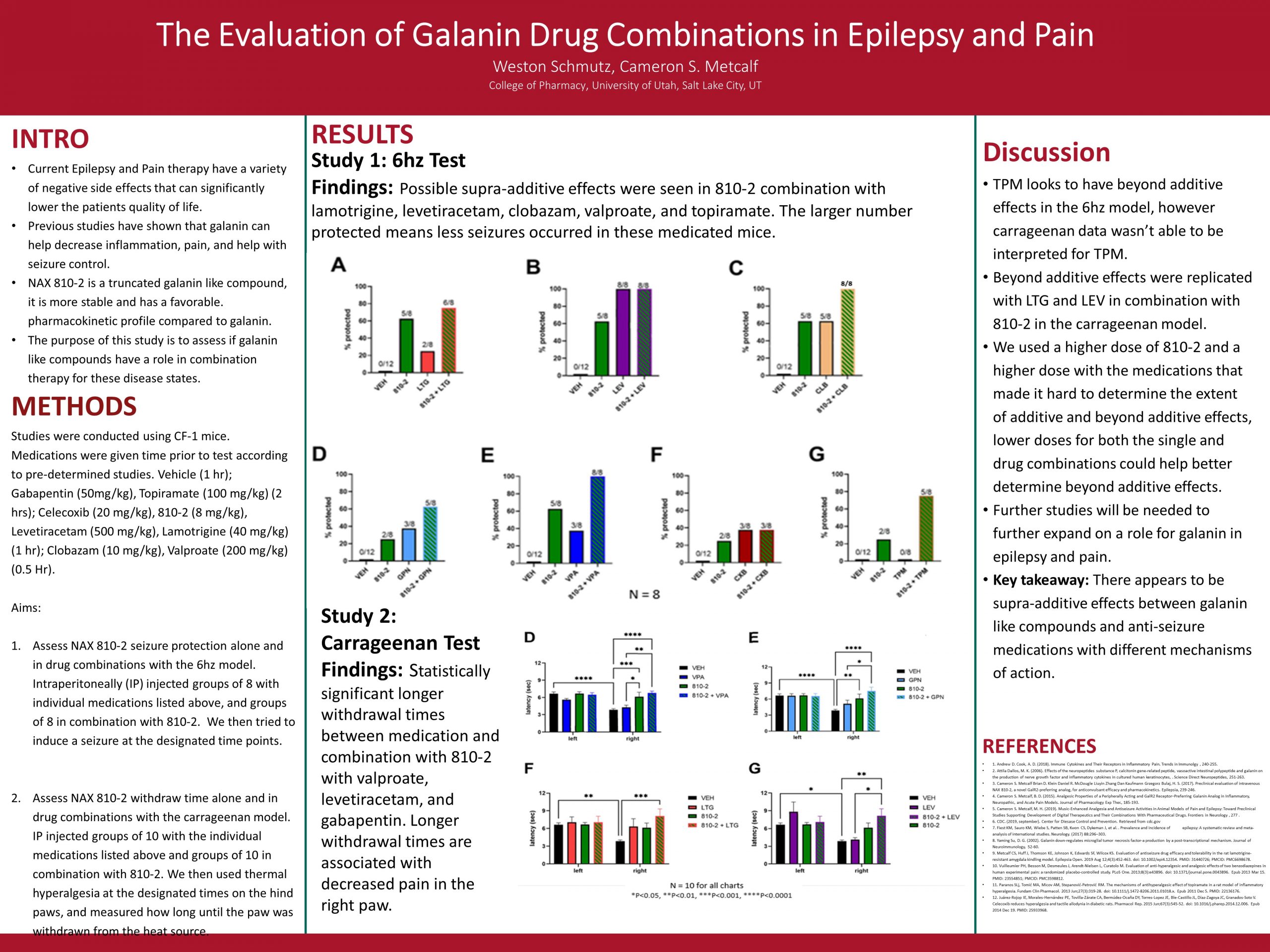Introduction: Epilepsy and pain are neurological disorders that are in a great need of treatment innovation. Our objective of this study was to evaluate the addition of galanin analogs to current seizure and pain therapy.
Methods: We assessed for supra-additive effects for several drug combination with NAX 810-2 on groups of CF-1 mice in 6hz seizure model, and the carrageenan pain assay model. We also performed quantitative polymerase chain reactions for the presence of inflammatory cytokines.
Results: In the mouse corneal kindling model (32 mA) Nax 810-2 drug combinations that may show interest to further study for supra-additive effects are levetiracetam, lamotrigine, clobazam, valproate, and topiramate. The carrageenan model also supports there may be supra-additive effects with levetiractem, gabapentin, and valproate.
Conclusion: This study added evidence to support data on galanin interactions with medications, and has helped add other medications that may have a potential synergistic effect that could be further studied in the future.
Recommend0 recommendationsPublished in College of Pharmacy, Virtual Poster Session Spring 2021



Responses
Great use of color figures in your poster, Weston! Really interesting methodology. What do you think should be the next study that should be conducted to further the knowledge base on this subject?
Thank you Dr. Witt! I think the next tests should be running the 6hz and carrageenan tests again for the medications that we weren’t able to determine if there were supra-additive effects. I also think a good step to take while performing this experiment would be taking paw and brain tissue samples of the combinations that did show supra-additive effects, and assessing the presence of inflammatory factors and their RNA precursors. The presence or lack of inflammatory factors would help give further evidence in how Galanin like medications work to lower seizure activity and pain.
Critical work. Thanks.
Thank you Jane!
Nice poster and work, Weston! I’m glad the pandemic didn’t preclude you being able to complete the studies. I’m curious to what extent you think these additive/potentially synergistic effects reflect pharmacodynamic affects at the cellular or CNS level vs. pharmacokinetic effects in which the addition of the Galanin agent alters the peripheral metabolism of the primary compound, thus increasing it’s effective dose?
Thanks Dr. Keefe! So with what we know about how galanin works in the body there is evidence that suggests it slows neuronal firings through a pre-synaptic mechanism (possibly increased potassium permeability), and slows the formation of TNF-a RNA leading to it’s anti-seizure and anti-inflammatory effects.
We expect the synergistic effects to be due to pharmacodynamic affects at the synapse. Which is why we chose a variety of medications that have mechanisms pre-synapse, post-synapse, and other mechanisms, to determine if the synergy was shown mostly in compounds that had a similar pre-synaptic mechanism.
It could be possible that there is a pharmacokinetic interaction where it slows the breakdown of the primary compounds, but there isn’t any evidence I am aware of on the breakdown of NAX 810-2 in the nervous system to determine for sure.
Hi Weston! I liked your poster; very straight-forward with easy to grasp ideas (for us non-bench types!). It is great to see that you have identified possibly a new avenue for synergistic mgmt of seizure therapy. Good work!! I bet those mice want to run away from you!! Hope all is well!! Thank you!
Thank you Dr. Orlando!
Great job, Weston! Dr. Metcalf has mentioned your project to me a number of times, and I am super impressed with how all your data came together. My upcoming project with the lab will mainly be focusing on lesioning of the amygdala and how that translates to respiratory neurocircuitry in SUDEP, but I also hope to look at the expression of galanin and galanin receptors in the brain tissue of a few different animal models to evaluate potential changes in the galanin system as well. Thank you for providing such great insight- I imagine this data will be very useful not only for myself but also for the many others who are exploring effects of galanin in epilepsy and pain.
Comments are closed.